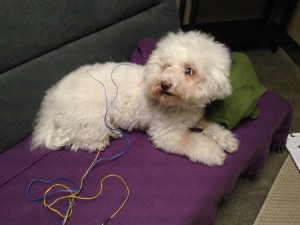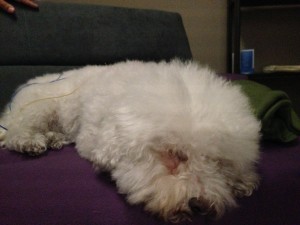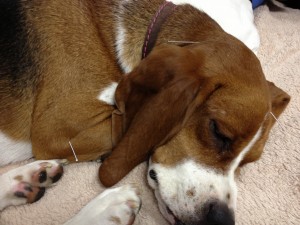Many people have tried acupuncture for themselves at one time or another. And while it seems innocent enough - tiny needles placed in the skin - few understand how it works or where this ancient healing art comes from.
For centuries acupuncture has been used by Asian cultures to treat almost every known malady to man. About 3000 years ago, the Chinese started adapting the practice for animals, primarily war horses. Since then veterinary acupuncture has evolved to include food animals, zoo animals, aquatic animals and pets. In the United States veterinary acupuncture began picking up steam in the 60’s and has now grown to include thousands of licensed practitioners.
How does it work? According to Traditional Chinese Veterinary Medicine (TCVM), energy courses through channels (or meridians), which are situated in perfect symmetry on either side of the body. TCVM says that disease occurs because of energy imbalances in the body, usually along these channels. Acupuncture involves the placement of very thin needles at specific acupuncture points in the body to rebalance the energy, or Qi (“chee”). These points can also be activated using small injections of fluid, gentle electrical currents or moxibustion (an herb that is heated and placed over certain acupuncture points to warm and activate them.)
What the Chinese intangibly referred to as Qi, western medicine has proven to be (at least in part) blood, nerves and hormones. From a western perspective, acupuncture works by promoting circulation, stimulating nerves and causing the release of certain hormones, such as endorphins and cortisol. Respected studies from western medicine, both human and animal, have proven acupuncture to be a valid modality for the treatment of painful conditions like sciatica and arthritis.
At DTLAvets we practice an integrated approach to veterinary medicine, offering both eastern and western therapies to our patients. We have incorporated acupuncture to treat a variety of conditions such as pets with spinal disc disease, arthritis, painful inflammation in the mouth, seizures, urinary incontinence, dermatologic disorders as well as palliative cancer care and many others.
How do you get a pet to stay still? Surprisingly most animals do quite well and stay relatively still and quiet during the session. At DTLAvets we have a dedicated acupuncture room with a cozy sofa, some pillows and blankets. First the doctor and owner will chat. Then the doctor will feel the pulses of the pet and look at the tongue (these are the most important parts of an eastern examination). We let the pet and owner chill out to relaxing Zen-type music. Once everyone is comfy, we place our needles and then we’re on our way! Depending on the nature of the condition we may also incorporate gentle vibrations of electricity or certain heated herbs. The doctor will often leave the room and most animals actually fall asleep during their session (some owners do too!) Twenty minutes later the session is done. Take a look at some of our patients during their treatments…
Little Franco receives acupuncture for disc disease.
...and falls asleep during his treatment.
Sweet Mackenzie resting during her session to treat her seizures.
Gentle Gus benefitted from acupuncture to alleviate pain from a cancerous mass at his hip
Check out our website for more info on this service. Schedule a consultation with us to find out if acupuncture can benefit your pet!




